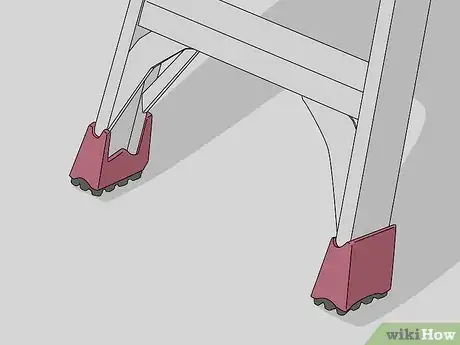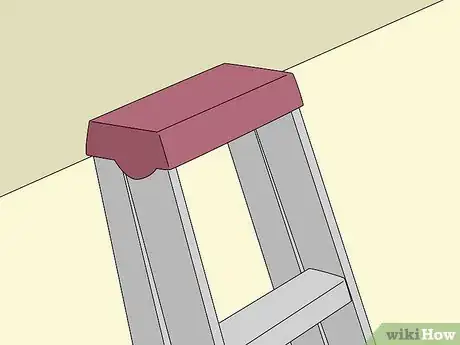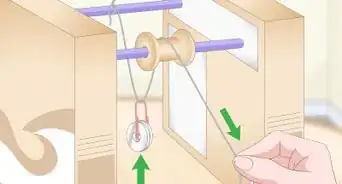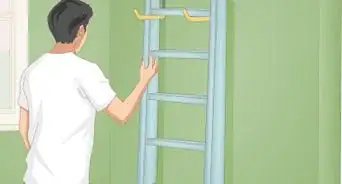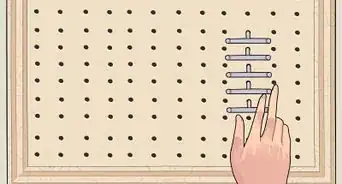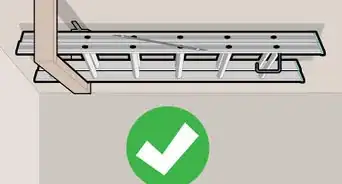This article was co-authored by Allen Lee. Allen Lee is a Home Improvement Specialist and the Owner of Honest Lee Handyman Services, a licensed and insured handyman business servicing Sacramento, California, and surrounding areas. Working with homeowners and businesses to get their small repairs done in a timely and efficient manner, Honest Lee Handyman Services provides gutter and dryer vent cleaning along with fixture, fence, drywall, and toilet repairs.
There are 9 references cited in this article, which can be found at the bottom of the page.
This article has been viewed 229,949 times.
Ladders are everywhere, and they come in many different forms to fit many different needs. Using ladders can bring you to great heights, but without proper technique, they can send you back to the earth a little too quickly. However, employing proper technique can make ascending a ladder as safe as any other tool in the garage. Everything from proper ladder material to proper ladder angle may seem obvious, but are extremely important.
Steps
Using The Ladder
-
1
-
2Set the ladder at a 75° angle with the ground. The simplest way to achieve this is by standing with your toes touching the feet of the ladder and extending your arms forward. Your palms should be able to reach a rung of the ladder when your arms are fully extended. If the angle is too steep, the ladder could tip backward; too shallow and it could slide out or bend in the middle.[3]
- You can also achieve this angle by pulling the feet of the ladder away from the wall about ¼ of the total length of the ladder.
Advertisement -
3Make sure the feet are secure. Always place feet parallel to the wall and on firm, level ground. It is never safe to place your ladder on top of any objects to gain additional height.
- On soft ground, flip the ladder feet up to expose the spurs and stomp on the bottom rung to penetrate the ground.
- On uneven ground, a ladder leveler is the only safe way to effectively extend one leg of the ladder.[4]
- If possible, you can also bolt a cleat into the ground behind the feet to aid against slipping.
-
4Make sure the top of the ladder is secure. Both side rails should be equally supported and placed on an even surface. The ladder should not slide or wobble when you put weight against it. Whenever practical, tie off the top of the ladder to further secure it to the wall.[5] [6]
- If the ladder is fully extended, you may want to tie off the midsection as well.
-
5Climb the ladder maintaining three points of contact. You should always climb one rung at a time, moving only one hand or one foot at a time. Always face the ladder as you climb, and only use the rungs to climb opposed to the side rails.[7]
Taking Extra Precautions
-
1Utilize accessories to help stabilize the top of the ladder. There are a variety of tasks that call for a ladder, and a variety of accessories for the top of ladders that can help you more easily and safely complete those tasks.[8]
- Soft "mitts" that slip over the top of the side rails can provide extra grip and protect the surface from damage done by the ladder.
- Ladder stabilizers basically widen the points at which the top of the ladder rests. This can be useful to protect fragile siding or to clear the width of a window.
- Single support attachments are necessary whenever the ladder is leaned against a surface narrower than the width of the ladder, like a telephone pole. They mount to the ladder above the top rung between the two side rails.
-
2Avoid aluminium ladders when working with electricity. Aluminium ladders tend to be the lightest weight, but they are also electrical conductors. So whenever you need to place your ladder near a live electrical line or fixture, or even when working with corded power tools, it is best to use a wooden or fiberglass ladder, as neither are electrical conductors.[9] [10]
- Even if you are using wooden or fiberglass ladders, try to avoid coming into contact with any electrical wires.
-
3Inspect your ladder for damage often. Checking all the moving parts, like feet and rung locks, as well as the overall integrity of the ladder, can prevent the worst of accidents. It’s also important that the ladder is clean of any foreign substances that could be slippery, sticky, corrosive, conductive, or otherwise an added hazard to using the ladder.[11]
-
4Refer to your ladder’s safety label. All ladders are sold with a label on the outside of one of the side rails that details the ladders max length, duty (or max weight), and other helpful safety information. Remember that max weight includes the weight of your body, clothes, tools, and any accessories attached to the ladder.
Expert Q&A
Did you know you can get expert answers for this article?
Unlock expert answers by supporting wikiHow
-
QuestionIs a fiberglass or aluminum ladder better?
 Allen LeeAllen Lee is a Home Improvement Specialist and the Owner of Honest Lee Handyman Services, a licensed and insured handyman business servicing Sacramento, California, and surrounding areas. Working with homeowners and businesses to get their small repairs done in a timely and efficient manner, Honest Lee Handyman Services provides gutter and dryer vent cleaning along with fixture, fence, drywall, and toilet repairs.
Allen LeeAllen Lee is a Home Improvement Specialist and the Owner of Honest Lee Handyman Services, a licensed and insured handyman business servicing Sacramento, California, and surrounding areas. Working with homeowners and businesses to get their small repairs done in a timely and efficient manner, Honest Lee Handyman Services provides gutter and dryer vent cleaning along with fixture, fence, drywall, and toilet repairs.
Home Improvement Specialist
-
QuestionAre ladder levelers a good idea?
 Mark SpelmanMark Spelman is a General Contractor based in Austin, Texas. With over 30 years of construction experience, Mark specializes in constructing interiors, project management, and project estimation. He has been a construction professional since 1987.
Mark SpelmanMark Spelman is a General Contractor based in Austin, Texas. With over 30 years of construction experience, Mark specializes in constructing interiors, project management, and project estimation. He has been a construction professional since 1987.
Construction Professional
-
QuestionHow do you climb a step ladder safely?
 Mark SpelmanMark Spelman is a General Contractor based in Austin, Texas. With over 30 years of construction experience, Mark specializes in constructing interiors, project management, and project estimation. He has been a construction professional since 1987.
Mark SpelmanMark Spelman is a General Contractor based in Austin, Texas. With over 30 years of construction experience, Mark specializes in constructing interiors, project management, and project estimation. He has been a construction professional since 1987.
Construction Professional
Warnings
- Never face away from the ladder while you are standing on it.⧼thumbs_response⧽
- Do not try to move the ladder while still on it.⧼thumbs_response⧽
- Always look for overhead power lines near you before you set up the ladder!⧼thumbs_response⧽
- A fully-extended ladder is top-heavy, so lower the extension before moving it or the ladder could be unwieldy, especially on a windy day.⧼thumbs_response⧽
- Don't overreach to one side or another, simply move the ladder instead. This will take longer, but overreaching is the most common cause of falls from a ladder.[12]⧼thumbs_response⧽
References
- ↑ Allen Lee. Home Improvement Specialist. Expert Interview. 10 July 2020.
- ↑ https://www.youtube.com/watch?v=sWuOBu3GjHw&feature=youtu.be&t=11m15s
- ↑ https://www.osha.gov/SLTC/etools/construction/falls/4ladders.html
- ↑ https://www.americanladderinstitute.org/page/Ladders101
- ↑ Allen Lee. Home Improvement Specialist. Expert Interview. 10 July 2020.
- ↑ https://www.youtube.com/watch?v=sWuOBu3GjHw&feature=youtu.be&t=13m45s
- ↑ http://www.nsc.org/learn/safety-knowledge/Pages/Ladder-Safety-One-Rung-at-a-Time.aspx
- ↑ https://www.youtube.com/watch?v=sWuOBu3GjHw&feature=youtu.be&t=13m27s
- ↑ Allen Lee. Home Improvement Specialist. Expert Interview. 10 July 2020.
About This Article
To climb a ladder safely, start by putting the ladder's feet parallel to the wall and on firm, level ground. When you do this, make sure both the side rails are flat against an even surface at the top of the ladder and there's no wobbling. Check the placement of the ladder by standing in front of it with your toes touching its feet. If you can extend your arms forward and touch your palms to one of the rungs you're all set! When you’re ready to climb, keep three points of contact, moving just one hand or foot at a time. To learn more from our Contractor co-author, like how to check your ladder for damage each time you use it, keep reading!



